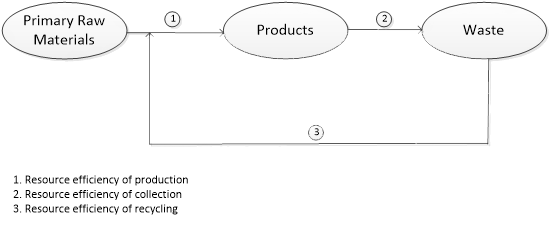Circularity & Sustainable Development
In order to move towards a more sustainable development and at the same time create opportunities for economic growth, a fundamental transformation in producer and consumer behaviour is needed. It is crucial to increase the resource efficiency of production optimizing the use of materials in the design stage and to find new materials as alternatives to non-renewable ones (e.g. optical fiber instead of copper, biopolymers instead of polymers from oil). In many countries, it is also necessary to improve the resource efficiency of collection. However, what is most urgent is to minimize the amount of materials which are currently disposed of, through effective recycling (cf. Figure below).

Figure. Material flow and resource efficiencies
The waste management infrastructure of Europe is already well developed so that it achieves an almost complete collection of solid wastes into a variety of controlled bulk material flows [Golder Europe EEIG (2004)]. The picture for the follow-up step, the recycling of raw materials such as steel, non-ferrous metals, polymers and glass from these flows, is less positive. Materials value recovered from waste represents less than 0.5% of European GDP, even at the most favourable of economic conditions (EEA report). In most EU countries, recycling provides only between 5% and 15% in value of the raw materials used in manufacturing and construction [Hüther, M. (2010)]. The fundamental issue is that policymakers still lack an effective key performance indicator for stimulating the recycling industry. Therefore although recycling is currently playing an important role in the circular economy perspective, it is necessary to radically change the metric used so far to compute the recycling rate. The Circular Economy Index (CEI) we propose uses a different approach. It aims at introducing the economic value of the materials embedded in consumers products as the property to be measured and accounted.
Projects:
- Toward a better environment: implementation of energy-saving buildings in China (ENER-C).
- Human Resources Development for the improvement and protection of environment in Asia (ProtEA).
- Innovative Methodologies for Sustainable Waste Management (InnoMan).
- WASTE management focussing on: Knowledge and Integration to create Transnational economic development (WASTEKIT).
- Magnetic Sorting and Ultrasound Sensor Technologies for Production of High Purity Secondary Polyolefins from Waste (W2Plastics).
- Development of Recovery Processes for Recycling of Valuable Components from Flat Panel Displays (In, Y, Nd) for the Production of High Added Value Nano Products (RECYVAL-NANO).